Hector Carrillo has a path to prosperity, and it happened by accident.
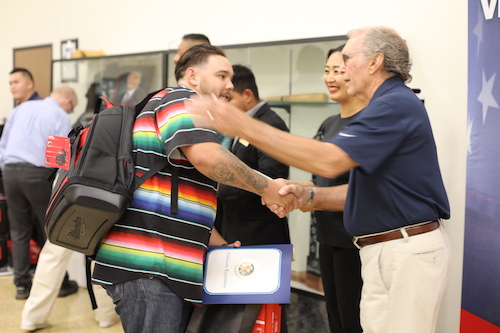
|
| San Bernardino Mayor Pro-Tem Fred Shorett congratulates Jayden Ceniceros on is VEEP graduation. Ceniceros transitioned out of the Army in 2021 and now is an apprentice at Riverside, Calif., Local 440.
|
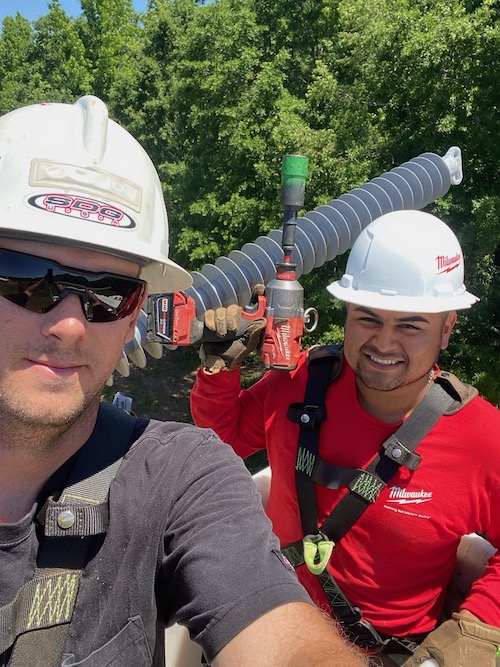
|
| Orlando, Fla., Local 222 member Alex Hernandez going through Select SkillBridge Veteran Program training in Newnan, Ga., with instructor Phil Burge, right.
|
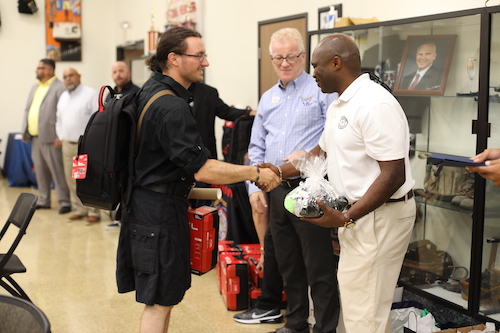
|
| Quincy Lunford, right, Helmets to Hardhats Southwest regional manager, congratulates VEEP graduate Calvin Toone. Toone served in the Army and is a San Bernardino, Calif., Local 477 apprentice. Greg McMurphy of the Electrical Training Alliance looks on.
|
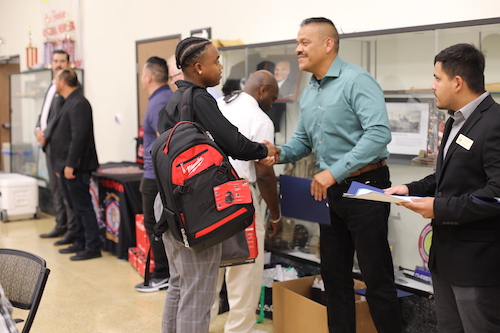
|
| VEEP graduate Jordan Afolayan is congratulated by John Echevarria, a member of the Colton, Calif., City Council, upon completing the pre-apprenticeship program. Afolayan recently transitioned out of the Army and is an apprentice at San Bernardino, Calif., Local 477.
|
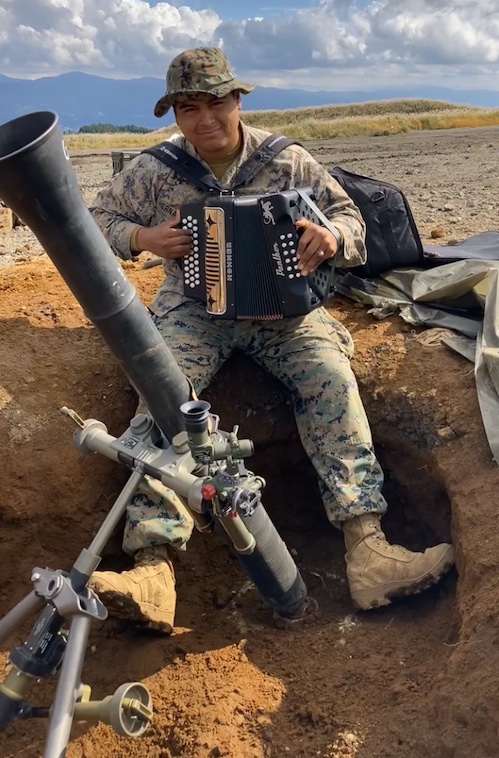
|
| Alex Hernandez on active duty with Marine Corps at Camp Lejeune, N.C. Brother Hernadez is now a lineman and member of Orlando Local 222.
|
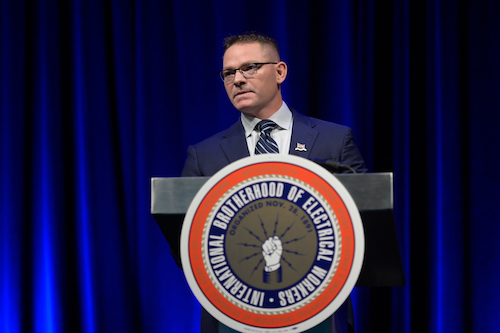
|
| Helmets to Hardhats Executive Director Martin Helms, a member of Akron, Ohio, Local 306.
|
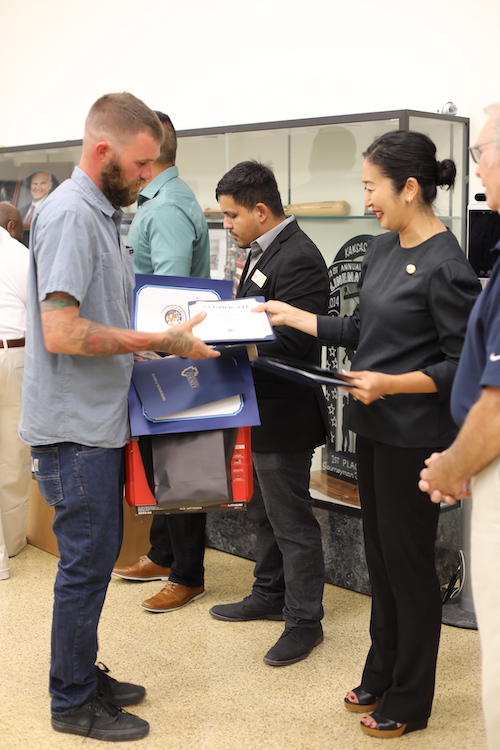
|
| San Bernardino, Calif., Mayor Helen Tran congratulates Samuel Stanson II on his VEEP graduation. Stanson served in the Marine Corps for 10 years and is now a Local 477 apprentice.
|
Carrillo was an Army paratrooper stationed at Joint Base Elmendorf-Richardson in Alaska in 2020, just a few months from being discharged, and wasn't sure how to navigate post-military life. He wanted to work with his hands, although he wasn't exactly sure doing what.
"The Army takes care of you and provides a lot, but it's a really scary transition, not knowing what is going to happen," he said. "I knew it was going to be a struggle."
Then by chance he overheard a representative of Anchorage Local 1547 talking to another service member about the IBEW's Veteran's Electrical Entry Program, or VEEP.
Carrillo told Local 1547 officials he was interested — and found himself in VEEP's pre-apprenticeship program about one month later, learning electrical skills and getting paid for seven weeks while still on active duty. He took part in a graduation ceremony after completing the program.
Better yet, there was a local union near where he grew up in Southern California that was accepting VEEP graduates: Riverside Local 440.
He is now a fourth-year apprentice there. He and his wife have a 3-year-old daughter and can plan for the future.
"As soon as my time was up with the Army, it all kind of fell into place," he said.
Carrillo's story is not uncommon among veterans who enter VEEP. Started in 2019, it is run in conjunction with the Electrical Training Alliance, the IBEW's longtime national training partner.
VEEP eases the transition to civilian life, a time when many veterans struggle with uncertainty about where they will live and how they will support their families. It is an anxious time. VEEP also provides the IBEW with a pool of skilled apprentices who are used to committing to a goal and working as a team. And it's a chance to support the men and women who served their country.
"What we are doing with VEEP is something every industry in the country should look at doing," said Timothy Auman, lead organizer and VEEP representative at San Bernardino, Calif., Local 477, who works with other Southern California locals to place VEEP graduates.
Auman, who spoke at the Membership Development Conference earlier this year on the importance of VEEP, said it's vital that local unions move beyond past ways of thinking about apprentices and roll out the welcome mat for these men and women.
"You're bringing in a veteran that tests into our apprenticeship. They already have the skills. It also recognizes where the veteran is when they leave the military. They're often young when they enlist and don't have a substantial savings account set aside. It can take months and months for a spot in an apprenticeship to open. We can put them in the pre-apprenticeship right away."
International President Kenneth W. Cooper wants to hear more stories like Carrillo's in the near future.
"Programs like VEEP are more than just the right thing to do by our veterans," Cooper said. "They're essential if we are going to meet the increasing demand for skilled construction workers and ensure the new electrical grid is built by union members."
It hits close to home for Cooper, who has a son who served in the Navy and a son-in-law who served in the Air Force, in addition to a Korean War veteran father-in-law. "Every local union must make room for graduates of VEEP," he said.
Military Experience Gives an Edge
Those involved in the program said VEEP graduates enter the apprenticeship better prepared than most because of the military background and because they have gone through the pre-apprenticeship, which Auman and others said covers much of what a typical first-year apprentice learns.
"I get a lot of positive feedback from our members," Auman said. "Once someone gets a VEEP member in their crew, they want another one."
Local 440 Lead Organizer Bernie Balland echoed those thoughts, adding that "with the VEEP program and the pre-apprenticeship, one of the good things is they are confident in using those skills."
In addition to Alaska, Southern California is one of the strongest areas for the program. There are about a dozen bases in the area, representing every branch of the military.
Plus, tens of millions of people were raised there. Many went on to the military and want to return home there after serving.
And finally, there's no lack of work. Local 440 has committed to accepting as many as 10 VEEP graduates per year.
"We're in a fortunate position that we have work we're able to commit to," Balland said.
The program is now available to U.S. military members worldwide due to online learning, further broadening its reach. VEEP applicants must have a local union that will accept them for direct entry upon completion of the program to be considered.
Program graduates have been accepted into more than 100 inside locals, but finding a local to take on an applicant is too often a challenge, said Greg McMurphy, assistant director of the Electrical Training Alliance and its VEEP inside coordinator. McMurphy and IBEW officials said that must change if VEEP is to meet its potential.
"We have more locals saying they will accept graduates than in the past, but we still need to work on that," he said.
The current inside training centers are at Local 1547, Los Angeles Local 11 and San Diego Local 569. Locals 440 and 477 have a joint program. Salt Lake City Local 354 will have its first training cohort in January.
Atlanta Local 613 has been approved for its first cohort, which will use a combination of hybrid and in-person training.
Adrian Sauceda, director of inside construction organizing, said recruiting military veterans is a top priority.
"We need to show those transitioning veterans that the door to the IBEW is open," he said. "Everyone cheered and rah-rahed [when Sauceda mentioned the topic at the Membership Development Conference], but now it's time to update their apprenticeship standards and use a program like Helmets to Hardhats or VEEP. We must show by action we're trying to help our veterans."
Helmets to Hardhats
McMurphy noted that VEEP will not be able to accept all the applicants into its pre-apprenticeship program for the foreseeable future.
But it can steer them to Helmets to Hardhats and other programs for veterans, he said.
"We're just a flare that is telling them: 'The IBEW is interested in you. We value you,'" said McMurphy, an inside wireman and member of Kennewick, Wash., Local 112. "Come see us about a job. The ones we can't get seats in training, we want to hand off to the training centers and get them in the industry."
Helmets to Hardhats has been helping veterans with the transition to careers in the trades since 2002. It's a partnership among 15 trade unions, including the IBEW. VEEP is crucial, especially with its pre-apprenticeship program, but Helmets to Hardhats is better positioned to meet the immediate needs of some veterans joining the IBEW, Sauceda said.
"We have the connections," said Helmets to Hardhats Executive Director Martin Helms, an Army veteran and member of Akron, Ohio, Local 306. "We have relationships in the military and the building trades. We have the databases to make things happen. If you're a service member going through the transition, you should have heard of us.
"There's no one program that can hit all the masses," he said of the complementary nature of VEEP and Helmets to Hardhats. "The analogy I make is this: You never go into battle with just one plan. You use multiple techniques to get the win."
Helms said about one-third of veterans who fill out Helmets to Hardhats paperwork expressing an interest in the trades say their top choice is to work in the electrical field. He calls it the "sexy choice" in construction because wages are good, there's always a need for electricity, and it takes a high level of skill to become an electrician or lineman.
Only about 21% of those end up becoming IBEW members. That number should be closer to 50%, he said.
Sauceda said the IBEW's field organizers are committed to doing a better job of contacting veteran applicants.
"If we don't call on them, they're going to go work nonunion," Sauceda said. "When that happens, it's awfully hard to get them back."
Helmets to Hardhats' work with the IBEW extends to Canada. That relationship will only strengthen, said Pete Cool, a member of Halifax, Nova Scotia, Local 1928 and the First District representative on the IBEW's Veterans Committee.
"This will create a lot of opportunities for the locals, as well as helping the veterans find employment by getting them some training to work in the trades," he said.
Cool joined the Veterans Committee in 2022 and has assembled a similar committee specific to Canada. It has about 12 members and is meeting monthly, he said. He plans to eventually have 30 members.
Sauceda said some local unions' apprenticeship committees feel like they are relinquishing control of their programs if they accept a VEEP graduate or someone from Helmets to Hardhats via a guaranteed entry spot.
He countered that they are getting someone who has proven they are qualified because of their service and the pre-apprenticeship program.
"As long as I'm here, this is not going to be lip service," he said.
'Mindset We Had in the Marine Corps'
It's not just about inside wiremen. VEEP and other programs for veterans are vitally important to maintaining a quality line workforce, said Utility Director Donnie Colston.
"What you look for in a lineman is an eagerness to learn and someone who understands the importance of reporting to work daily, especially in emergencies," said Colston, a journeyman lineman and member of Louisville, Ky., Local 2100. "When you talk to a veteran, he or she understands they must be on the job every day and finish the task. In the military, they're on 24-hour call."
Alex Hernandez was based in Okinawa, Japan, with the Marine Corps, knowing he would be discharged in just a few months. He looked at various options, including VEEP, when he came across the SkillBridge Military Program. It's a Defense Department program that helps veterans transition to civilian life with the help of donations from corporate partners.
Hernandez used it to land a spot at the Selcat SkillBridge Veteran Program in Newnan, Ga. He underwent training while still on active duty. After returning to civilian life, he became a member of Orlando, Fla., Local 222 — about 90 miles from where he grew up — and now is working to rebuild the grid in Puerto Rico.
"Coming from a military standpoint, a lot of people working here have the mindset we had in the Marine Corps," he said.
Hernandez was even able to qualify for a home loan by showing the lender his projected earnings as a lineman.
His advice for other veterans getting ready to return to civilian life:
"Don't wait," he said. "You've got to go out and get it. I had a couple of buddies that sat around and waited when they got out. They're not working and they're struggling. Get after it. There's plenty of money to be made. All it takes is a little want-to, and you'll make it."
Jason Iannelli, director of outside curriculum for the National Training Alliance, said graduates are sent to one of three training centers: Selcat/SSVP AJATC in Newnan, Ga.; Lazy Q Ranch in La Grange, Texas; and Missouri Valley AJATC/Midwest Line College in Indianola, Iowa.
Benefits to participants in each program vary. The LaGrange facility doesn't require any fees, for instance. Veterans can use G.I. Bill benefits to pay fees at the other facilities.
It isn't easy to land a spot in VEEP's outside program. Iannelli said there are usually about 900 VEEP applicants annually for about 120 spots. That might fluctuate depending on the demands of utility companies, he said. Training is intense, and some don't make it through the 180-day program, although VEEP candidates generally perform better than other apprentices, said Iannelli, a member of Philadelphia Local 126. "Our goal with VEEP is to make it a seamless transition from the pre-apprenticeship to the apprenticeship."
West Frankfort, Ill., Local 702 member Darren Hess left the Marine Corps in 2005, long before VEEP was founded. But he advises veterans to make use of any program that helps them attain IBEW membership, noting that he uses many of the skills he learned in the military on the job today.
"Being a lineman is a physical job," said Hess, who served a tour in Afghanistan. "You've got to be able to get out there and climb poles and reach things you never thought you could reach in your life. That definitely helped me, and the leadership aspect I learned in the military helped me tremendously."
Good for IBEW, Good for Veterans
Experts who study veterans say the initial months after being discharged are often the most fraught. Many lose the sense of purpose they felt in the service, and when they lose the structure of the military, they can drift in civilian life.
Finding a family-supporting job might prove more difficult than expected, especially if they want to move to a specific area, such as where they or their spouse grew up.
That's where VEEP is especially beneficial. The service members know they have a path to a terrific career, often months before being discharged.
"Throughout my lifetime, I have seen so many veterans who have a fulfilling military career and upon exiting fall into that gap," said Local 440 Political Director Venessa Ingalls, who grew up near the Marine Corps Air Ground Combat Center in Southern California. "They did not have the fulfillment of working in our industry and the camaraderie of being a member of our union and all that comes with it."
"In my opinion, it's a no-brainer," she said. "If an opportunity is there for us to help veterans and build bridges, it's incumbent on us to do it."
Ingalls, a journeyman wireman, also hopes it becomes a tool to attract more women who served in the military.
"From my personal experience of working in the field, some of the women who have had the most seamless and successful careers in the IBEW have been veterans," she said.
"Seamless" is a word the IBEW wants all military members and veterans to have in mind when they show an interest in membership.
Like with any applicant for an apprenticeship, nothing is given. But with lessons learned in the military, along with development resources from programs like VEEP and Helmets to Hardhats set up veterans for a successful career in the community of their choice, while helping the IBEW meet the demand for skilled electricians.
One needs to look no further than Carrillo for proof.
"We're big into being close to family," he said. "Having a good job, and being close to them, are two big pluses."